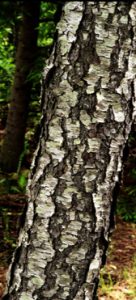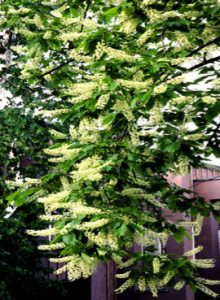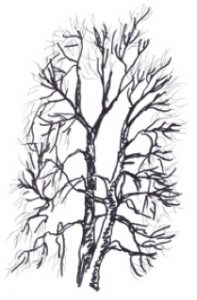Bulletin #2575, Native Trees and Shrubs for Maine Landscapes: Black Cherry (Prunus serotina)
Developed by Marjorie Peronto, Associate Extension Professor, University of Maine Cooperative Extension; and Reeser C. Manley, Assistant Professor of Horticulture, University of Maine.
For information about UMaine Extension programs and resources, visit extension.umaine.edu.
Find more of our publications and books at extension.umaine.edu/publications/.
Go native!
This series of publications is the result of a five-year research project that evaluated the adaptability of a variety of native trees and shrubs to the stresses of urban and residential landscapes in Maine. Non-native invasive plants pose a serious threat to Maine’s biodiversity. Plants such as Japanese barberry, shrubby honeysuckle, and Asiatic bittersweet, originally introduced for their ornamental features, have escaped from our landscapes, colonizing natural areas and displacing native plants and animals. By landscaping with native plants, we can create vegetation corridors that link fragmented wild areas, providing food and shelter for the native wildlife that is an integral part of our ecosystem. Your landscape choices can have an impact on the environment that goes far beyond your property lines.
Description
Form: a tall, columnar tree becoming rounded with age, with ascending branches and slightly weeping twigs
Size: 50 to 60 feet tall, half as wide
Ornamental characteristics:
- loose, pendulous spikes of white spring flowers
- fruit clusters transition from green to red to purplish black, contrasting with shiny summer foliage
- yellow to orange fall color
Landscape Use
Black cherry needs full sun and a moist but well-drained soil to flourish. Use it as a single specimen tree, placing it in the landscape where you can appreciate its spring flowers, ruggedly handsome bark, and autumn foliage, but where its small black cherries will not stain your driveway or patio when they fall from the tree in late summer.
Over the years, any black cherry will serve as host to eastern tent caterpillars and possibly black knot disease. If you are intolerant of the caterpillar webs and accompanying defoliation, or of the black, knobby fungus growths that cover black knot-infected branches, avoid using this species.
Despite these problems, black cherry deserves a spot in any landscape devoted to wildlife. The cherries are an important food for songbirds and small mammals, and the plant is host to over 200 species of butterflies and moths.
Culture
Hardiness: USDA zone 3b
Soil requirements: prefers moderately to well-drained soils
Light requirements: full sun
Stress tolerances:
soil compaction — intolerant
pollution — intolerant
deicing salts — tolerant
urban heat islands — tolerant
drought — tolerant
seasonal flooding — very intolerant
Insect and disease problems: black knot and eastern tent caterpillar
Wildlife Value
From spring through summer, black cherry is host to over 200 species of butterflies and moths, including coral and striped hairstreaks as well as Canadian and Eastern tiger swallowtails. In winter, the cherries are eaten by some 70 bird species, including ruffed grouse, ring-necked pheasants, woodpeckers, cedar waxwings, thrushes, and grosbeaks. At times the birds may become intoxicated on fermented berries; look for glassy-eyed, wobbling birds under late-season fruiting trees.
Many mammals also enjoy the cherries. Bears and raccoons will climb the trees for the fruit, while foxes, chipmunks, rabbits, white-footed mice, and squirrels frequently feed on fallen fruits.
Twigs and leaves contain high levels of hydrocyanic acid (also called prussic acid), which is poisonous to cattle and humans. However, deer and moose are not sensitive to these compounds and readily browse black cherry.
Maintenance
Irrigation: During the establishment period, defined as one year after planting for each inch of trunk diameter at planting time, water your trees regularly during the growing season. Give the root zone of each tree 1 inch of water per week; in general, a tree’s root zone extends twice as wide as its canopy. After the establishment period, provide supplemental irrigation during periods of severe drought.
Fertilization: Landscape trees and shrubs should not be fertilized unless a soil test indicates a need. Correct soil pH, if necessary, by amending the backfill soil. No nitrogen fertilizer should be added at planting or during the first growing season.
To learn more about native woody plants
Visit the Eastern Maine Native Plant Arboretum at University of Maine Cooperative Extension’s Penobscot County office, 307 Maine Avenue in Bangor. Established in 2004, the arboretum displays 24 different native tree and shrub species that can be used in managed landscapes.
Reviewed by Cathy Neal, Extension professor, University of New Hampshire Cooperative Extension.
Photos by Reeser C. Manley.
Illustration by Margery Read, Extension Master Gardener.
This series of publications and the associated research were made possible in part by the Maine Forest Service’s Project Canopy.
Information in this publication is provided purely for educational purposes. No responsibility is assumed for any problems associated with the use of products or services mentioned. No endorsement of products or companies is intended, nor is criticism of unnamed products or companies implied.
© 2008
Call 800.287.0274 (in Maine), or 207.581.3188, for information on publications and program offerings from University of Maine Cooperative Extension, or visit extension.umaine.edu.
In complying with the letter and spirit of applicable laws and pursuing its own goals of diversity, the University of Maine System does not discriminate on the grounds of race, color, religion, sex, sexual orientation, transgender status, gender, gender identity or expression, ethnicity, national origin, citizenship status, familial status, ancestry, age, disability physical or mental, genetic information, or veterans or military status in employment, education, and all other programs and activities. The University provides reasonable accommodations to qualified individuals with disabilities upon request. The following person has been designated to handle inquiries regarding non-discrimination policies: Director of Institutional Equity and Title IX Services, 5713 Chadbourne Hall, Room 412, University of Maine, Orono, ME 04469-5713, 207.581.1226, TTY 711 (Maine Relay System).





